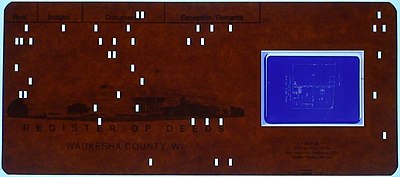
An aperture card is a type of punched card with a cut-out window into which a chip of microfilm is mounted. Such a card is used for archiving or for making multiple inexpensive copies of a document for ease of distribution. The card is typically punched with machine-readable metadata associated with the microfilm image, and printed across the top of the card for visual identification; it may also be punched by hand in the form of an edge-notched card.[1] The microfilm chip is most commonly 35mm in height, and contains an optically reduced image, usually of some type of reference document, such as an engineering drawing, that is the focus of the archiving process. Machinery exists to automatically store, retrieve, sort, duplicate, create, and digitize cards with a high level of automation.
Aperture cards have several advantages and disadvantages when compared to digital systems. While many aperture cards still play an important role in archiving, their role is gradually being replaced by digital systems.
- ^ Cady, Susan A. (1999). "Microfilm technology and information systems". In Bowden, Mary Ellen; Hahn, Trudi Bellardo; Williams, Robert Virgil (eds.). Proceedings of the 1998 Conference on the History and Heritage of Science Information Systems. ASIS monograph series. Medford, NJ: Published for the American Society for Information Science and the Chemical Heritage Foundation by Information Today. pp. 177–186. CiteSeerX 10.1.1.99.3796. ISBN 1573870803. OCLC 42022214.
Early aperture cards were sometimes mounted on McBee Keysort cards that could be notched on the margins to indicate an index term and then sorted manually with tools resembling knitting needles.
